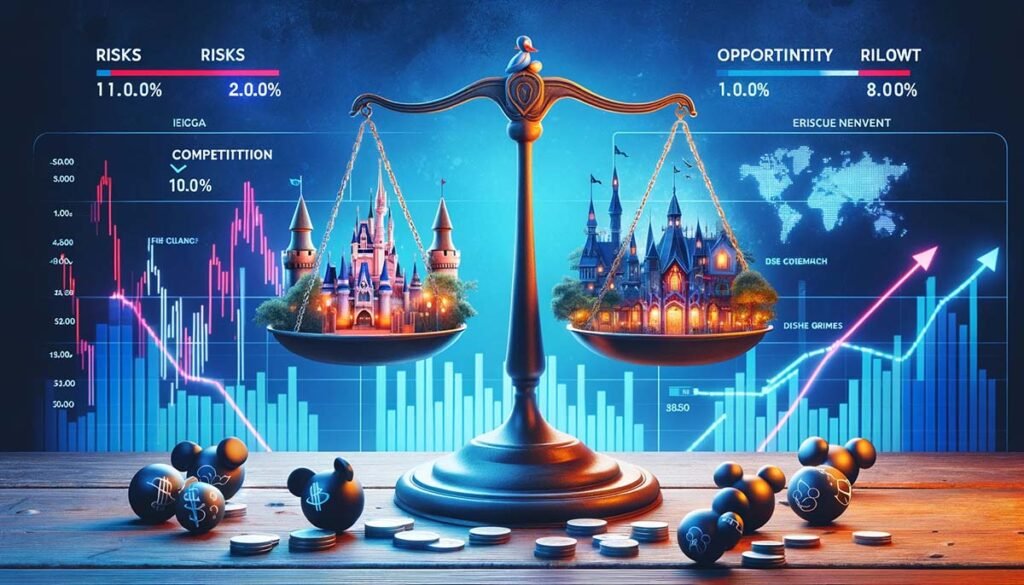Fintechzoom Disney Stock: A Comprehensive Guide

Introduction
Disney is one of the most well-known companies in the world, with a diverse portfolio that spans movies, theme parks, and streaming services. For investors, Disney stock offers an opportunity to be part of this global entertainment giant. But is it a good investment? That’s what we’re going to explore.
In this article, we’ll break down everything you need to know about Disney stock (DIS). From understanding the company’s financial health to analyzing the stock’s current performance, we’ll cover it all. You’ll also find practical steps on how to invest in Disney stock and tips on what to watch for.
Whether you’re a seasoned investor or just getting started, this guide will help you make an informed decision. By the end, you’ll have a clear picture of Disney’s stock potential and whether it fits your investment goals. Let’s dive in and take a closer look at Disney’s financials and stock outlook.
Understanding Disney as a Company

Company Overview
The Walt Disney Company is a global entertainment leader, with interests spanning various sectors. From movies to theme parks, Disney has built a powerful brand that appeals to all ages. The company operates across several key segments:
- Media Networks: Includes television networks like ABC, ESPN, and Disney Channel.
- Parks, Experiences, and Products: Disney’s theme parks and resorts, including Disneyland and Disney World, which generate substantial revenue.
- Studio Entertainment: Includes production of films and animation, with franchises like Marvel, Star Wars, and Pixar.
- Direct-to-Consumer: Disney’s streaming services such as Disney+, ESPN+, and Hulu have become central to its strategy.
The company has seen several leadership changes, with Bob Iger returning as CEO in 2022. His strategic decisions have been pivotal in reshaping Disney’s approach, especially regarding its streaming services and content production.
Financial Highlights
Disney has a history of strong financial performance. The company’s revenue primarily comes from its media networks and parks. Over the past few years, Disney has also seen significant growth in its streaming services.
- Market Capitalization: As of now, Disney’s market cap is approximately $210 billion.
- Revenue Growth: Disney’s overall revenue continues to grow, fueled by the success of Disney+ and its blockbuster films.
- Earnings Per Share (EPS): Disney’s EPS has fluctuated due to investments in streaming and content, but it shows a strong long-term growth trend.
- Dividend Payments: Disney increased its dividend by 33% for 2025, signaling confidence in its financial future.
These strong financial metrics make Disney a compelling choice for many investors.
Overview of Fintechzoom Disney Stock Analysis

What is Fintechzoom?
Fintechzoom is a financial news and analysis platform that tracks market trends and offers stock insights. It provides investors with data-driven articles, stock analysis, and financial forecasts. By compiling information from various sources, Fintechzoom helps investors make informed decisions based on current market conditions.
The platform covers a broad range of stocks, including those from well-known companies like Disney. It analyzes stock price movements, earnings reports, and other relevant data to give a clear picture of a company’s financial health and potential growth.
Fintechzoom Disney Stock Insights
Fintechzoom’s analysis of Disney stock focuses on key metrics like its price-to-earnings (P/E) ratio, earnings growth, and dividend yield. Disney stock has received a “Strong Buy” recommendation from many analysts, based on its financial stability and growth prospects in streaming and media.
- Price Target: The 12-month price target for Disney stock is approximately $124.13, suggesting a potential upside of about 6.5% from its current price.
- Growth Drivers: Disney’s success with Disney+ and the recent growth of its box office franchises are major factors that analysts are optimistic about.
- Challenges: However, competition in the streaming market and rising production costs could pose risks.
These insights provide a solid foundation for investors evaluating Disney as part of their portfolio.
Detailed Financial Analysis of Disney Stock

Current Stock Performance
Disney’s stock, traded under the ticker symbol DIS, has experienced fluctuations in recent years, reflecting broader market trends and the company’s internal changes. As of December 2024, Disney’s stock is priced at around $116.50 per share, showing a slight decrease of 0.42% from the previous close. This dip comes after a period of strong performance fueled by the success of Disney’s streaming services and blockbuster films.
- Recent Stock Trends: Disney’s stock has been volatile, reflecting shifts in investor sentiment regarding its streaming strategy and media networks. The company’s heavy investment in Disney+ and other digital platforms has drawn both praise and scrutiny.
- Intraday High/Low: On any given day, Disney’s stock can range between a high of $117.25 and a low of $116.08, demonstrating relatively low short-term volatility.
- Comparison with Market: Disney’s stock has largely performed in line with broader market indices like the S&P 500, which suggests its stability amid market fluctuations.
Despite occasional dips, the stock’s longer-term performance indicates steady growth. Analysts remain confident in Disney’s ability to capitalize on its key revenue streams, including streaming services, movie franchises, and theme parks.
Fundamental Analysis
Disney’s fundamental metrics reveal a strong company with steady growth potential, even if faced with some challenges in the short term. Key indicators, such as Earnings Per Share (EPS) and Price-to-Earnings (P/E) ratio, are important in assessing the company’s valuation.
- Earnings Per Share (EPS): Disney’s EPS shows a healthy growth trajectory. For the fiscal year 2024, the company reported earnings of $5.28 per share, up from $4.62 in 2023. This increase highlights Disney’s ability to generate profits, even amid heavy investments in streaming.
- Price-to-Earnings (P/E) Ratio: The P/E ratio for Disney currently stands at around 22.0. This figure is slightly above the industry average, suggesting that investors are willing to pay a premium for Disney stock due to its future growth prospects, particularly in streaming and entertainment.
- Revenue Streams: Disney’s diverse revenue streams help cushion the company against downturns in any one segment. While media networks and parks and resorts remain dominant, the growth in streaming and studio entertainment has been substantial.
Despite the pressures in the streaming market, Disney remains a fundamentally strong company with a promising long-term outlook.
Technical Analysis
Technical analysis focuses on stock price trends, patterns, and market sentiment to predict future movements. For Disney, key indicators show a mixed but generally favorable outlook.
- Moving Averages: Disney’s stock is currently trading just below its 50-day moving average, which stands at $118.35, suggesting a slight downward short-term trend. However, it is still above its 200-day moving average of $110.28, indicating a positive long-term trend.
- Relative Strength Index (RSI): Disney’s RSI is at 52, indicating that the stock is neither overbought nor oversold. This neutral stance suggests that the stock could continue moving within a range, making it a potentially stable investment for traders.
- Support and Resistance Levels: In the short term, Disney’s stock faces resistance around $120, while support exists near $115. A breakout above $120 could signal further upside, while a drop below $115 may indicate further downside risk.
- Volume Trends: Trading volumes for Disney stock are steady, with occasional spikes driven by news of major releases or financial reports. This shows investor interest is high but not overly volatile, which supports long-term investment.
While Disney’s stock may face short-term fluctuations, its technical outlook suggests a solid base for future gains.
Comparative Analysis
When compared to its competitors, Disney remains a strong player in the media and entertainment space.
- P/E Ratio Comparison: Disney’s P/E ratio of 22.0 is higher than Netflix’s P/E of 19.5, reflecting investor confidence in Disney’s long-term growth despite higher short-term costs.
- Revenue Growth: Disney’s revenue from theme parks, media networks, and streaming continues to outperform other media giants, including Warner Bros and NBCUniversal, in terms of growth rates.
- Market Capitalization: With a market cap of over $210 billion, Disney is far larger than streaming-only services like Netflix but faces stiff competition from platforms like Amazon and Apple, which have deeper pockets.
Overall, Disney’s diversified business model and steady revenue growth make it a more balanced investment option compared to its streaming-only competitors. While the company faces challenges, especially in streaming, it has the financial strength to overcome these hurdles.
Investment Guide-How to Invest in Disney Stock
Investing in Disney stock can be a solid way to build wealth, but it’s important to approach it methodically. Here’s a step-by-step guide to help you get started with investing in Disney (DIS).
Step-by-Step Guide
Step 1: Research and Analysis
Before buying any stock, it’s crucial to understand the company’s financial health and market outlook. With Disney, this means looking into:
- Earnings Reports: Review Disney’s quarterly earnings reports to understand its revenue, profit margins, and growth.
- Industry Trends: Track trends in the entertainment and streaming industries. Disney’s performance is closely tied to the success of Disney+, its movie releases, and theme park operations.
- Stock Performance: Study how Disney’s stock has performed over time, especially during market downturns.
Use resources like financial news sites, investor reports, and Disney’s investor relations page to gather relevant data.
Step 2: Open a Brokerage Account
Once you’ve done your research, you’ll need to open a brokerage account to buy Disney stock. This is a relatively straightforward process:
- Choose a Broker: Pick an online brokerage like E*TRADE, Charles Schwab, or Robinhood. Consider factors like commission fees, ease of use, and research tools.
- Fund Your Account: Link your bank account and deposit funds. Some brokers require a minimum deposit, so be sure to check this first.
- Verify Your Identity: Complete the necessary identification checks before proceeding to trade.
Once your account is ready, you can start buying shares of Disney.
Step 3: Select Investment Strategy
Next, decide how you want to invest in Disney:
- Long-Term Investment: If you’re in it for the long haul, consider buying and holding Disney shares for years, capitalizing on its growth in streaming, media, and theme parks.
- Dividend Income: Disney’s growing dividend payments can provide a steady stream of income for investors who want regular returns.
- Short-Term Trading: For those who want to capitalize on price swings, you can buy and sell shares more frequently, but this requires more time and market monitoring.
Choose a strategy that aligns with your financial goals and risk tolerance.
Step 4: Execute the Trade
Now that your account is set up and your strategy is clear, it’s time to buy Disney stock:
- Market Order vs. Limit Order: A market order buys Disney stock at the current price, while a limit order allows you to set a price you’re willing to pay. If Disney’s price hits your target, the order will execute automatically.
- Buy Shares: Enter the number of shares you want to buy. Be sure to double-check your order before finalizing it to avoid errors.
After executing the trade, your shares will appear in your brokerage account.
Step 5: Monitor and Adjust
Once you’ve invested in Disney stock, your work isn’t done. Keep an eye on the stock’s performance and news about the company. Here’s what to focus on:
- Quarterly Earnings Reports: These provide valuable insights into Disney’s financial health and growth prospects.
- Market Trends: Follow changes in the media and entertainment landscape that could impact Disney.
- Adjust Strategy: If necessary, adjust your investment strategy. For example, if you’re in it for the long-term, you might ignore short-term price fluctuations.
Stay informed and be ready to make changes as needed.
By following these steps, you can start investing in Disney stock and work towards achieving your financial goals.
Risks and Opportunities in Disney Stock Investment

Investing in Disney stock can be rewarding, but like all investments, it comes with risks and opportunities. Let’s break down both sides to help you make a more informed decision.
Risks
1. Market Volatility
Disney’s stock can be affected by overall market conditions. If the stock market declines, Disney’s stock is likely to feel the impact, even if the company itself is doing well. Economic downturns, inflation, and changes in consumer behavior can lead to stock price drops.
2. Competition in Streaming
Disney+ has become a key growth driver, but the streaming market is highly competitive. Companies like Netflix, Amazon, and Apple are investing heavily in original content. This means Disney needs to continue attracting new subscribers and retaining existing ones, which can be costly and uncertain.
3. Content and Production Costs
Producing high-quality content, such as films and TV shows, requires significant investment. Disney has to balance spending on content with profitability. If production costs rise or if films underperform, it could hurt Disney’s financial results.
4. Regulatory Risks
Changes in government regulations, especially around media and entertainment, could impact Disney’s operations. For example, new laws affecting streaming platforms or theme park operations could create challenges for the company.
Opportunities
1. Streaming Growth
Disney+ has shown impressive growth since its launch. With a global reach and exclusive content, Disney is well-positioned to compete in the growing streaming market. As more people subscribe to streaming services, Disney stands to benefit.
2. Theme Park Recovery
Disney’s theme parks took a hit during the pandemic but are now bouncing back. As travel and tourism continue to recover, Disney’s theme parks are expected to bring in significant revenue. Strong growth in international markets also offers new opportunities.
3. Content Expansion
Disney’s rich portfolio of intellectual property, including Marvel, Star Wars, and Pixar, continues to perform well at the box office. The company can continue monetizing these franchises with new films, TV series, and merchandise.
4. Dividend Growth
Disney has been increasing its dividend payouts. For income-focused investors, this is a sign of financial strength and stability. The company’s strong cash flow and profitability suggest that it may continue to raise dividends in the future.
By weighing these risks and opportunities, you can better understand Disney’s stock potential.
Expert Opinions and Market Sentiment
When considering an investment in Disney stock, it’s important to understand what the experts are saying and how the market feels about the company. Here’s a breakdown of expert opinions and market sentiment.
Analyst Ratings
Expert analysts have a generally positive outlook on Disney stock, though opinions vary based on their analysis of the company’s growth prospects and current risks.
- Buy Rating: Many analysts rate Disney as a “Buy” or “Strong Buy,” citing the company’s strong brand, solid financials, and growth in its streaming business. Disney+ has gained millions of subscribers worldwide, which bodes well for the company’s future revenue.
- Hold Rating: Some analysts have a “Hold” rating, especially given the intense competition in the streaming industry and potential challenges in the media networks segment. These experts suggest that Disney’s stock price could remain relatively flat in the short term.
- Price Targets: Analyst price targets for Disney typically range from $115 to $130, with the majority of analysts leaning toward a $124 target. This indicates a moderate upside potential from its current levels.
Overall, the sentiment is largely positive, though cautious, with analysts highlighting Disney’s diverse revenue streams and future growth potential.
Market Sentiment
The broader market sentiment toward Disney stock is also largely favorable, but investors are closely watching how the company adapts to ongoing challenges in the entertainment industry.
- Investor Confidence: After Bob Iger returned as CEO in 2022, investor confidence has strengthened. Many believe he will steer Disney through the tough competition in streaming and re-focus on core business areas like theme parks and content.
- Concerns Over Streaming Profitability: Despite strong subscriber growth, there are concerns about Disney’s profitability in streaming. Disney+ and Hulu are still in the investment phase, and their ability to generate profits in the future remains a key focus.
- Positive Long-Term Outlook: The general market sentiment remains positive about Disney’s long-term growth, driven by its content library, brand strength, and global market reach.
While there are some risks, Disney’s future growth prospects continue to attract favorable market sentiment.
Conclusion
Investing in Disney stock can be a smart move for many investors, but it’s important to consider both the risks and rewards. The company has strong fundamentals, driven by its diverse revenue streams, including media networks, streaming, and theme parks. Disney+ continues to show growth, and with its extensive library of content, the company is well-positioned in the competitive streaming space.
However, there are risks to watch. The streaming market is crowded, and Disney faces competition from companies like Netflix and Amazon. Rising production costs and market volatility could also impact short-term performance.
Despite these risks, expert analysts and market sentiment remain generally positive about Disney’s future. The company’s solid financials, strategic leadership under CEO Bob Iger, and recovery in theme parks point to a promising long-term outlook.
If you’re considering investing in Disney, do your research, understand your investment goals, and keep an eye on both the opportunities and challenges ahead.
Frequently Asked Questions (FAQ’s)
1. Is Disney stock a good investment right now?
Disney stock is considered a solid investment by many analysts, thanks to its strong brand, diverse revenue streams, and growth in streaming services like Disney+. However, the stock does face challenges, especially in the highly competitive streaming market. Long-term investors may find Disney appealing due to its stability, strong content library, and recovery in theme parks. That said, short-term volatility could occur, so it’s important to assess your investment goals before diving in.
2. What are the risks of investing in Disney stock?
There are a few risks to consider when investing in Disney stock:
- Streaming competition: Disney+ faces tough competition from Netflix, Amazon Prime, and others.
- Rising costs: High content production costs and challenges with profitability in streaming could impact earnings.
- Market volatility: Like all stocks, Disney can be affected by broader market movements, economic downturns, and consumer behavior changes.
These factors could influence the stock’s performance, but Disney’s diversified business model helps mitigate some of these risks.
3. How does Disney’s dividend policy work?
Disney has been increasing its dividend payments, which is appealing for income-focused investors. The company raised its dividend by 33% for 2025, signaling confidence in its financial position. Keep in mind, dividends are typically paid quarterly, and while Disney’s dividend growth is strong, any significant changes in company strategy could impact future payouts.
4. What is Disney’s future growth potential?
Disney’s future growth potential is significant, especially with its strong foothold in streaming and media. The continued success of Disney+ and the expansion of its content library, along with the recovery of its theme parks, are key growth drivers. Additionally, Disney’s ability to monetize its well-known franchises like Marvel, Pixar, and Star Wars adds to its long-term prospects. While short-term challenges exist, its diverse revenue sources provide a solid foundation for continued growth.
5. How can I buy Disney stock?
To buy Disney stock, follow these steps:
- Do your research: Understand Disney’s financials and outlook.
- Open a brokerage account: Choose an online broker like E*TRADE, Schwab, or Robinhood.
- Fund your account: Deposit money into your brokerage account.
- Place your order: Decide on the number of shares you want to buy and execute the trade.
- Monitor your investment: Keep track of Disney’s performance and adjust your strategy if needed.
Be sure to assess your financial goals and risk tolerance before making a purchase.
If you found our content helpful don’t forget to share it on your social media: Twitter.
For more insightful articles related to business, please visit Bloghart.
